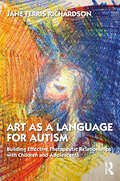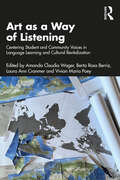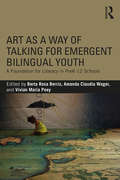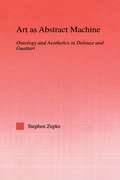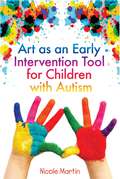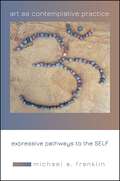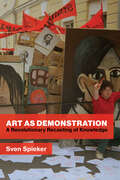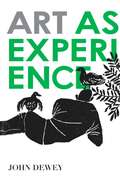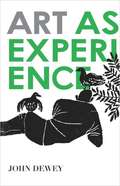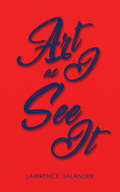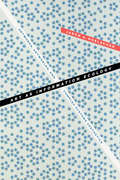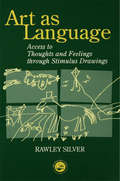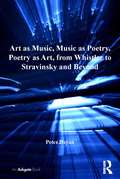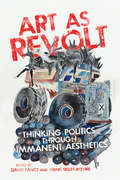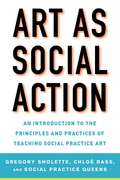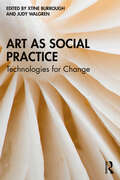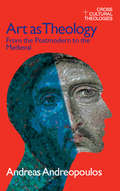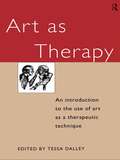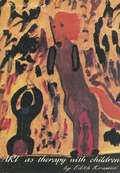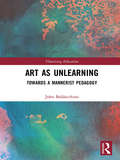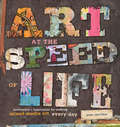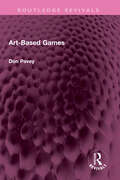- Table View
- List View
Art as a Language for Autism: Building Effective Therapeutic Relationships with Children and Adolescents
by Jane Ferris RichardsonArt as a Language for Autism addresses the clinical challenges that are common in working with autistic spectrum disorder by exploring how artistic expression can provide a communicative language for younger clients who are set in their thought processes and preferences. Exploring how both art and play-based approaches can be effective tools for engaging therapeutic work, this book introduces strategies to help young clients find expressive "languages" that can fully support communication, expression, and empathic understanding, as well as build skills for relaxation, calming, and coping. Building from a foundation of a client’s individual strengths and interests, this playful and integrative approach is informed by an awareness of the individual sensory profiles and the developmental needs of children and adolescents with autism. Through a greater awareness of these materials and processes for therapy, the reader will be able to create a space for their young clients to share what they know and care about. This exciting new book is essential reading for clinicians working with children and adolescents on the autism spectrum.
Art as a Way of Listening: Centering Student and Community Voices in Language Learning and Cultural Revitalization
by Amanda Claudia Wager Berta Rosa Berriz Laura Ann Cranmer Vivian Maria PoeyOffering a wealth of art-based practices, this volume invites readers to reimagine the joyful possibility and power of language and culture in language and literacy learning. Understanding art as a tool that can be used for decolonizing minds, the contributors explore new methods and strategies for supporting the language and literacy learning skills of multilingual students. Contributors are artists, educators, and researchers who bring together cutting-edge theory and practice to present a broad range of traditional and innovative art forms and media that spotlight the roles of artful resistance and multilingual activism. Featuring questions for reflection and curricular applications, chapters address theoretical issues and pedagogical strategies related to arts and language learning, including narrative inquiry, journaling, social media, oral storytelling, and advocacy projects. The innovative methods and strategies in this book demonstrate how arts-based, decolonizing practices are essential in fostering inclusive educational environments and supporting multilingual students’ cultural and linguistic repertoires. Transformative and engaging, this text is a key resource for educators, scholars, and researchers in literacy and language education.
Art as a Way of Talking for Emergent Bilingual Youth: A Foundation for Literacy in PreK-12 Schools
by Berta Rosa Berriz Amanda Claudia Wager Vivian Maria PoeyThis book features effective artistic practices to improve literacy and language skills for emergent bilinguals in PreK-12 schools. Including insights from key voices from the field, this book highlights how artistic practices can increase proficiency in emergent language learners and students with limited access to academic English. Challenging current prescriptions for teaching English to language learners, the arts-integrated framework in this book is grounded in a sense of student and teacher agency and offers key pedagogical tools to build upon students’ sociocultural knowledge and improve language competence and confidence. Offering rich and diverse examples of using the arts as a way of talking, this volume invites teacher educators, teachers, artists, and researchers to reconsider how to fully engage students in their own learning and best use the resources within their own multilingual educational settings and communities.
Art as Abstract Machine: Ontology and Aesthetics in Deleuze and Guattari
by Stephen ZepkeFirst Published in 2005. Routledge is an imprint of Taylor & Francis, an informa company.
Art as an Early Intervention Tool for Children with Autism
by Nicole MartinThe early years are the most critical period of learning for a child with autism. Therapeutic art-making can be a useful tool to tap into their imaginations and help them to express their thoughts and feelings. Art as an Early Intervention Tool for Children with Autism includes practical advice on helping a child move beyond scribbling, organizing the child's environment for maximum comfort and relaxation, and providing physical and sensory support. This book is packed with tips and suggestions for how to provide art therapy for children with autism -- covering topics such as the basic materials required, safety issues, how to set up a workspace, and ideas for managing difficult behavior. The author writes from a professional and personal perspective -- Nicole Martin is a qualified art therapist specializing in working with children with autism, and she also has a brother with autism. Perfect for busy parents and as a practical reference for professionals such as psychologists, teachers, occupational therapists, sensory integration therapists and anyone working with a child on the autism spectrum.
Art as Contemplative Practice: Expressive Pathways to the Self
by Michael A. FranklinDrawing upon his personal experience as a practitioner-researcher, visual artist, and cancer survivor, Michael A. Franklin offers a rich and thought-provoking guide to art as contemplative practice. His firsthand experience and original artwork complement this extensive discussion by consulting various practice traditions including yoga, rasa and darshan experiences, imaginal intelligence, and the contemplative instincts of select early twentieth-century artists. From this synthesis, Franklin suggests that we treat art as a form of yoga and meditation with the potential to awaken deeper insight into the fundamental nature of the Self. Exercises and rubrics are included that offer accessible instruction for any artist, meditation or yoga practitioner, art educator, or art therapist.
Art as Culture: An Introduction to the Anthropology of Art
by Evelyn Payne Hatcheran introduction of art as it relates to anthropology
Art as Demonstration: A Revolutionary Recasting of Knowledge
by Sven SpiekerHow artists wield demonstration to question the status quo both aesthetically and politically, marshaling art and education as powerful agents of change.Demonstration, in short, says: See here. It is the practice of pointing to something in order to explain or contest it. As such, Sven Spieker argues that demonstration has helped reshape art from the height of the Cold War to the late twentieth century, reformatting our understanding of how art and political engagement relate to each other. Focusing on Western Europe (especially Germany), Eastern Europe, and the United States, Art as Demonstration expands on contemporary discussions of art-as-protest, activism, and resistance. Spieker shows how a closer, more historical look at art&’s connection with demonstration reconnects us with earlier efforts, notably by the early twentieth-century avant-garde, to marshal art for the purpose of instruction and engagement.Art as Demonstration reconceives the history of postwar art in Eastern and Western Europe from the perspective of demonstration, understood formally (as a technique for showing and pointing) as well as politically (as protest, resistance, etc.). Close analyses of individual artworks reveal how the deployment of demonstration has changed over time. Spieker shows how &“protest&” and &“resistance&” organize art and artists not only politically but also and especially formally and aesthetically—a development of particular importance in the Cold War art and politics of Eastern Europe. The book illustrates how from the 1960s onward demonstration radically changed the way artists thought about art: no longer as an object but as a form of education.
Art as Experience
by John DeweyBased on John Dewey's lectures on esthetics, delivered as the first William James Lecturer at Harvard in 1932, Art as Experience has grown to be considered internationally as the most distinguished work ever written by an American on the formal structure and characteristic effects of all the arts: architecture, sculpture, painting, music, and literature.
Art as Experience
by John DeweyBased on John Dewey's lectures on esthetics, delivered as the first William James Lecturer at Harvard in 1932, Art as Experience has grown to be considered internationally as the most distinguished work ever written by an American on the formal structure and characteristic effects of all the arts: architecture, sculpture, painting, music, and literature.
Art as I See It
by Lawrence SalanderA working painter for over 50 years, and owner and director of the internationally renowned Salander-O'Reilly Galleries in New York City, where he was responsible for presenting over 600 museum quality exhibitions of art to the public, Salander is in a unique position to have a deep insight of all aspects of art and its making. This is an extremely personal book, and it is evident that Salander is both passionate and knowledgeable about his subject.
Art as Information Ecology: Artworks, Artworlds, and Complex Systems Aesthetics (Thought in the Act)
by Jason A. HoelscherIn Art as Information Ecology, Jason A. Hoelscher offers not only an information theory of art but an aesthetic theory of information. Applying close readings of the information theories of Claude Shannon and Gilbert Simondon to 1960s American art, Hoelscher proposes that art is information in its aesthetic or indeterminate mode—information oriented less toward answers and resolvability than toward questions, irresolvability, and sustained difference. These irresolvable differences, Hoelscher demonstrates, fuel the richness of aesthetic experience by which viewers glean new information and insight from each encounter with an artwork. In this way, art constitutes information that remains in formation---a difference that makes a difference that keeps on differencing. Considering the works of Frank Stella, Robert Morris, Adrian Piper, the Drop City commune, Eva Hesse, and others, Hoelscher finds that art exists within an information ecology of complex feedback between artwork and artworld that is driven by the unfolding of difference. By charting how information in its aesthetic mode can exist beyond today's strictly quantifiable and monetizable forms, Hoelscher reconceives our understanding of how artworks work and how information operates.
Art as Language: Access to Emotions and Cognitive Skills through Drawings
by Rawley SilverThrough the use of case studies and more than 150 illustrations of patient artwork, this book summarizes findings of cognitive development and art therapy practices.
Art as Medicine
by Shaun Mcniff"Whenever illness is associated with loss of soul," writes Shaun McNiff, "the arts emerge spontaneously as remedies, soul medicine." The medicine of the artist, like that of the shaman, arises from his or her relationship to "familiars"--the themes, methods, and materials that interact with the artist through the creative process. Art as Medicine demonstrates how the imagination heals and renews itself through this natural process. The author describes his pioneering methods of art therapy--including interpretation through performance and storytelling, creative collaboration, and dialoguing with images--and the ways in which they can revitalize both psychotherapy and art itself.
Art as Music, Music as Poetry, Poetry as Art, from Whistler to Stravinsky and Beyond
by Peter DayanIn 1877, Ruskin accused Whistler of ’flinging a pot of paint in the public’s face’. Was he right? After all, Whistler always denied that the true function of art was to represent anything. If a painting does not represent, what is it, other than mere paint, flung in the public’s face? Whistler’s answer was simple: painting is music - or it is poetry. Georges Braque, half a century later, echoed Whistler’s answer. So did Braque’s friends Apollinaire and Ponge. They presented their poetry as music too - and as painting. But meanwhile, composers such as Satie and Stravinsky were presenting their own art - music - as if it transposed the values of painting or of poetry. The fundamental principle of this intermedial aesthetic, which bound together an extraordinary fraternity of artists in all media in Paris, from 1885 to 1945, was this: we must always think about the value of a work of art, not within the logic of its own medium, but as if it transposed the value of art in another medium. Peter Dayan traces the history of this principle: how it created our very notion of ’great art’, why it declined as a vision from the 1960s and how, in the 21st century, it is fighting back.
Art as Revolt: Thinking Politics through Immanent Aesthetics
by David Fancy and Hans Skott-MyhreHow can we imagine a future not driven by capitalist assumptions about humans and the wider world? How are a range of contemporary artistic and popular cultural practices already providing pathways to post-capitalist futures? Authors from a variety of disciplines answer these questions through writings on blues and hip hop, virtual reality, post-colonial science fiction, virtual gaming, riot grrrls and punk, raku pottery, post-pornography fanzines, zombie films, and role playing. The essays in Art as Revolt are clustered around themes such as technology and the future, aesthetics and resistance, and ethnographies of the self beyond traditional understandings of identity. Using philosophies of immanence – describing a system that gives rise to itself, independent of outside forces – drawn from a rich and evolving tradition that includes Spinoza, Nietzsche, Deleuze, and Braidotti, the authors and editors provide an engrossing range of analysis and speculation. Together the essays, written by experts in their fields, stage an important collective, transdisciplinary conversation about how best to talk about art and politics today. Sophisticated in its theoretical and philosophical premises, and engaging some of the most pressing questions in cultural studies and artistic practice today, Art as Revolt does not provide comfortable closure. Instead, it is understood by its authors to be a “Dionysian machine,” a generator of open-ended possibility and potential that challenges readers to affirm their own belief in the futures of this world. Contributors include Timothy J. Beck (University of West Georgia), Mark Bishop (Independent Scholar), Dave Collins (University of West Georgia), David Fancy (Brock University), Veronica Pacini-Ketchabaw (University of Western Ontario), Malisa Kurtz (Independent Scholar), Nicole Land (Ryerson University), Eric Lochhead (Youth Author Calgary Alberta), Douglas Ord (Doctoral Student University of Western Ontario), Joanna Perkins (Independent Scholar), Peter Rehberg (Institute for Cultural Inquiry—Berlin), Chris Richardson (Young Harris College), Hans Skott-Myhre (Kennesaw State University), and Kathleen Skott-Myhre (University of West Georgia).
Art as Revolt: Thinking Politics through Immanent Aesthetics
by David Fancy Hans Skott-MyhreHow can we imagine a future not driven by capitalist assumptions about humans and the wider world? How are a range of contemporary artistic and popular cultural practices already providing pathways to post-capitalist futures? Authors from a variety of disciplines answer these questions through writings on blues and hip hop, virtual reality, post-colonial science fiction, virtual gaming, riot grrrls and punk, raku pottery, post-pornography fanzines, zombie films, and role playing. The essays in Art as Revolt are clustered around themes such as technology and the future, aesthetics and resistance, and ethnographies of the self beyond traditional understandings of identity. Using philosophies of immanence – describing a system that gives rise to itself, independent of outside forces – drawn from a rich and evolving tradition that includes Spinoza, Nietzsche, Deleuze, and Braidotti, the authors and editors provide an engrossing range of analysis and speculation. Together the essays, written by experts in their fields, stage an important collective, transdisciplinary conversation about how best to talk about art and politics today. Sophisticated in its theoretical and philosophical premises, and engaging some of the most pressing questions in cultural studies and artistic practice today, Art as Revolt does not provide comfortable closure. Instead, it is understood by its authors to be a “Dionysian machine,” a generator of open-ended possibility and potential that challenges readers to affirm their own belief in the futures of this world. Contributors include Timothy J. Beck (University of West Georgia) Mark Bishop (Independent Scholar), Dave Collins (University of West Georgia), David Fancy (Brock University), Veronica Pacini-Ketchabaw (University of Western Ontario), Malisa Kurtz (Independent Scholar), Nicole Land (Ryerson University), Eric Lochhead (Youth Author Calgary Alberta) , Douglas Ord (Doctoral Student University of Western Ontario), Peter Rehberg (Institute for Cultural Inquiry—Berlin), Chris Richardson (Young Harris College), Hans Skott-Myhre (Kennesaw State University), Kathleen Skott-Myhre (University of West Georgia), and Joanna Wasiak (Independent Scholar).
Art as Social Action: An Introduction to the Principles and Practices of Teaching Social Practice Art
by Gregory Sholette Chloë Bass Social Practice Queens"Art as Social Action . . . is an essential guide to deepening social art practices and teaching them to students." —Laura Raicovich, president and executive director, Queens MuseumArt as Social Action is both a general introduction to and an illustrated, practical textbook for the field of social practice, an art medium that has been gaining popularity in the public sphere. With content arranged thematically around such topics as direct action, alternative organizing, urban imaginaries, anti-bias work, and collective learning, among others, Art as Social Action is a comprehensive manual for teachers about how to teach art as social practice. Along with a series of introductions by leading social practice artists in the field, valuable lesson plans offer examples of pedagogical projects for instructors at both college and high school levels with contributions written by prominent social practice artists, teachers, and thinkers, including: Mary Jane Jacob Maureen Connor Brian Rosa Pablo Helguera Jen de los Reyes Jeanne van Heeswick Jaishri Abichandani Loraine Leeson Ala Plastica Daniel Tucker Fiona Whelan Bo Zheng Dipti Desai Noah Fischer Lesson plans also reflect the ongoing pedagogical and art action work of Social Practice Queens (SPQ), a unique partnership between Queens College CUNY and the Queens Museum.
Art as Social Practice: Technologies for Change
by Xtine Burrough Judy WalgrenWith a focus on socially engaged art practices in the twenty-first century, this book explores how artists use their creative practices to raise consciousness, form communities, create change, and bring forth social impact through new technologies and digital practices. Suzanne Lacy’s Foreword and section introduction authors Anne Balsamo, Harrell Fletcher, Natalie Loveless, Karen Moss, and Stephanie Rothenberg present twenty-five in-depth case studies by established and emerging contemporary artists including Kim Abeles, Christopher Blay, Joseph DeLappe, Mary Beth Heffernan, Chris Johnson, Rebekah Modrak, Praba Pilar, Tabita Rezaire, Sylvain Souklaye, and collaborators Victoria Vesna and Siddharth Ramakrishnan. Artists offer firsthand insight into how they activate methods used in socially engaged art projects from the twentieth century and incorporated new technologies to create twenty-first century, socially engaged, digital art practices. Works highlighted in this book span collaborative image-making, immersive experiences, telematic art, time machines, artificial intelligence, and physical computing. These reflective case studies reveal how the artists collaborate with participants and communities, and have found ways to expand, transform, reimagine, and create new platforms for meaningful exchange in both physical and virtual spaces. An invaluable resource for students and scholars of art, technology, and new media, as well as artists interested in exploring these intersections.
Art as Theology: From the Postmodern to the Medieval
by Andreas AndreapoulosReligion and spirituality are key aspects of the contemporary art scene. Following Ronald Barthes' 'death of the author' - which argued for the dissociation of work from creator - works of art have withdrawn as independent objects, giving way to a growing religious awareness or practice. 'Art and Theology' examines the connection between art and religion in ancient Jewish drama, Greek tragedy, the Renaissance, the Byzantine icon and the medieval cathedral. The book explores how art lost its sacred character in the late Middle Ages and how the current withdrawal or 'death' of art and the fusion of the limits of art and life are consistent with the medieval view of the religious icon.
Art as Therapy: An Introduction to the Use of Art as a Therapeutic Technique (Social Science Paperbacks Ser. #Vol. 265)
by Tessa DalleyArt as Therapy introduces the theory and practice of art therapy in a concise, accessible and informative way. Tessa Dalley's introduction gives an overview of basic issues, research and development. Subsequent chapters, written by specialists, are chosen to demonstrate the ways in which art therapy can be applied to different client groups, in a variety of clinical settings. These include children, adolescents suffering from anorexia nervosa, the mentally handicapped, the elderly and terminally ill, those in psychiatric hospitals and prison inmates. Illustrated case studies provide visual explanations for the art therapy processes and the final chapter discusses training for the profession. Art as Therapy has been welcomed by art therapists, social workers, psychologists, nurses and teachers.
Art as Therapy with Children (2nd Edition)
by Edith KramerArt as Therapy with Children has been an invaluable text for students of art therapy since its original printing in 1971. Though the settings and populations about which Edith Kramer wrote have changed considerably in the past two decades, the human condition and the need to understand and assist children in trouble remains unaltered. Edith Kramer's description of her methods and theories hold up as well as the methods and theories themselves.
Art as Unlearning: Towards a Mannerist Pedagogy (Theorizing Education)
by John BaldacchinoArt as Unlearning makes an argument for art’s unlearning as a mannerist pedagogy. Art’s pedagogy facilitates a form of forgetfulness by extending what happens in the practice of the arts in their visual, auditory and performative forms. The concept of learning has become predominantly hijacked by foundational paradigms such as developmental narratives whose positivistic approach has limited the field of education to a narrow practice within the social sciences. This book moves away from these strictures by showing how the arts confirm that unlearning is not contingent on learning, but rather anticipates and avoids it. This book cites the experience and work of artists who, by unlearning the canon, have opened a diversity of possibilities by which we make and live the world. Moving beyond clichés of art’s teachability and what we have to learn through the arts, it advances a scenario where unlearning is uniquely presented to us by the diverse practices that we identify with the arts. The very notion of art as unlearning stems from and represents a fundamental critique of the constructivist pedagogies that have dominated arts education for over half a century. This book will be of great interest to academics, researchers and postgraduate students in the fields of education, philosophy of education, history of education, pedagogy of art and art education. It will also appeal to educators, art educators, and artists interested in the pedagogy of art.
Art at the Speed of Life: motivation + inspiration for making mixed-media art every day
by Pam CarrikerOffering terrific mixed-media art projects, as well as great tips for getting organized and inspired, Art at the Speed of Life is a treasure chest of ideas for the artist whose fiery enthusiasm for creating art goes up in smoke after that frantic pace of a long day. Author and mixed-media artist Pam Carriker will prove to you that art and life can co-exist productively and happily, while making daily creative outlets a reality and not just wishful thinking.Each chapter in Art at the Speed of Life includes both essays and project ideas from a variety of contributors, including Suzi Blu, Lisa Bebi, Christy Hydeck, Paulette Insall, Cate Calacous Prato. It all begins with prepatory advice on how to manage your supplies and physically make space for you to work. This is followed by more than 15 projects that are inspiring, yet easy to complete on even the tightest of schedules and includes fun techniques such as assemblages, image transfers, and collages that are sure to keep you motivated. Plus, a bonus seven-day project journal helps you track your work as you go. Offering a unique combination of realistic time-management tips, inspiring essays, and easy-to-fit-in projects, Art at the Speed of Life will help you realize your dream of making art every day easily and happily.
Art-Based Games (Routledge Revivals)
by Don PaveyThe visitor to an Art Arena game is confronted with an enormous piece of paper covering one wall of the room. Groups of players are at work painting, some with spontaneity or abandon, others with thoughtful precision. Back from the wall are knots of players calling our apparently cryptic information to those at work on the paper, or transmitting it in coded sounds using whistles, pipes and various home-made instruments. Colours are phased across the wall, sometimes colliding, sometimes mingling, or encircling each other. But what is the connection between the sound flow and the painting?This book, originally published in 1979, describes the beginnings of a new approach to art education – an approach based on the use of games in art. The games draw not only upon artistic and design skills, but also upon those that teachers in all subjects try to develop in their pupils: logical thinking, breadth of judgement, imagination and sensibility in handling materials and media. They also provide a vehicle for familiarizing players with a wealth of concepts and data from different topics. The approach aims at promoting group work and cooperative interaction, and has proved to be of interest to social workers and to teachers of disabled and difficult children. It has been tried out with an unusual variety of groups, from mixed and low ability to groups of gifted children, students and adults, and while the level of playing has varied, the games have elicited high involvement from participants.While referring to game theory and research, the book is essentially practical, giving instructions for inventing and playing games, and descriptions of a number of games played by different groups. The end of the book gives a detailed list of concepts and suggestions for further reading, and lists of materials and suppliers.
